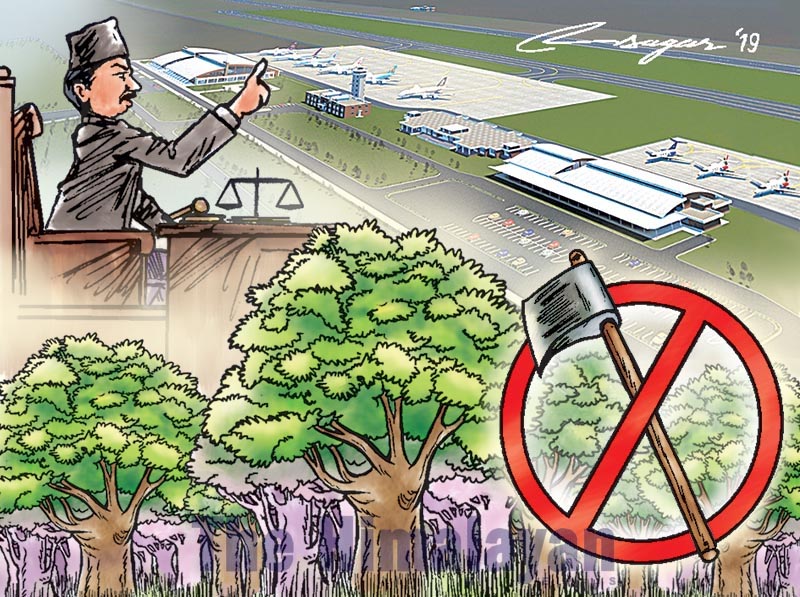Clearing trees at Nijgadh: Govt-community bonhomie needed
Either the government should have the teeth strong enough to calm down the opposition as in the case of Narita Airport in Japan or take the local population into confidence and complete the construction
The proposed international airport at Nijgadh is again in the news, perhaps for the umpteenth time now, and this time because of the Supreme Court’s order to stop the felling of trees. A few months back, the court in India had issued a similar order to halt the massacre of trees in Mumbai around Arey housing colony, which was being cleared for the parking of Mumbai Metro. This incident also reminds one of the Chipko Movement, launched by Sundar Lal Bahuguna in the Seventies in India by clinging to the trees.
The objective was to prevent the clearing of forests on the pretext of development hatched by money-mongering developers.
The reckless cutting of trees leads to massive deforestation, finally resulting in environmental degradation. Environmental degradation with population explosion and technological diffusion form a trinity, which will pose a grave problem in the new millennium, according to Paul Kennedy in his book entitled ‘Preparing for the Twenty-First Century’ that sold like hot cakes in the market when it hit the stands towards the end of the twentieth century.
The history of aircraft and airports goes back a long time. It is said that Kubera, the business tycoon, had a plane called Puspak, which was a kind of a pilotless aircraft, and it used to take direction as per the imagination of the passenger.
Rama is said to have come back to Ayodhya after victory over Ravana in glittery Lanka on this plane after Bibhishan, the newly-crowned king, presented it to Rama. Ravana, nasty as he was, is said to have snatched this plane from Kubera.
The east may have exotic stories of a mythical past, but modern aviation activity started from the west in Carolina, the United States, when the Wright brothers invented the aeroplane in the year 1903.
Interestingly, Rana prince and scientist Gehendra Shumsher had also made a model of a plane, machine gun, steam-run motor and cannon with the help of Tirtha Prasad and Muse Thapa during this time in Nepal.
But then Prime Minister Chandra Shumsher hatched a sinister conspiracy by serving slow poison to Gehendra Shumsher, banishing Tirtha Prasad from the country and putting Muse Thapa behind bars for seven years.
It was a huge setback for science, technology and innovation in the country, from which it has yet not been able to rise.
The planes and airports have changed beyond imagination to such an extent that it is difficult to believe they could take their present form, marked by grandioseness and gigantism. What started as a simple two-person carrier passenger plane, invented in 1914, has now transformed into a dizzy Boeing 777X Jet that can carry 384 passengers at a time.
Similarly, airports have been through six generations, beginning with a landing strip with passenger facilities provided in huts. Some of them can still be seen in Nepal, like the one in Jumla.
The sixth one is the big hangar terminal building type, such as the breathtaking international airport in Beijing, which was opened last September-end. It has been constructed to handle 72 million passengers per year by 2025, which will be almost three times the population of Nepal. Designed by the legendary lady architect, the late Zaha Hadid, it cost an astronomical $12 billion, which is about 40 per cent of Nepal’s GDP.
In Nepal, the national flag carrier, Royal Nepal Airlines, was established in 1957. The earliest airport was what is now known as Sanu Gaucharan, which is located near Gyaneswore in Kathmandu, before it moved to the present Tribhuvan International Airport. The Indian ambassador first landed in a Beechcraft Bonanza at this airport. Nepal has now about 50 airports, small and medium, dotted across the country. Nijgadh International Airport was mooted a long time back, but it is seeking to go the Melamchi way in view of the long time that it has taken for its take off.
Airports have been facing opposition during their construction in the past as well as in the present. A similar protest was launched back in the Seventies in Japan against the construction of Narita airport. The demonstrations turned violent, claiming the lives of three riot police. One young protester hanged himself. But the government accomplished the construction of the airport despite heavy demonstrations going side by side. More recently, a protest erupted in South Korea in connection with the construction of the airport on Jeju island.
The government had declared that the project was feasible, but the local community pointed at certain flaws in the project, which the Government had to ultimately accept. The government is now working with the community hand in glove and making all the activities transparent during its construction.
Experience thus shows that there are two ways to go ahead in the face of opposition in connection with the implementation of projects.
Either the government should have the teeth strong enough to calm down the opposition as in the case of Narita or take the local population into confidence and complete the construction. The first one does not seem to be possible in the present context of Nepal.
The government should win the hearts and minds of the community people by working in a spirit of bonhomie as well as brotherhood and move together to make it a reality.






